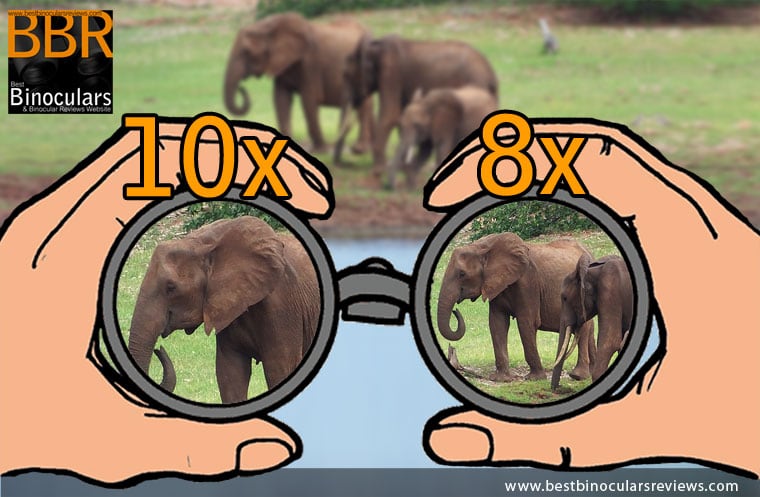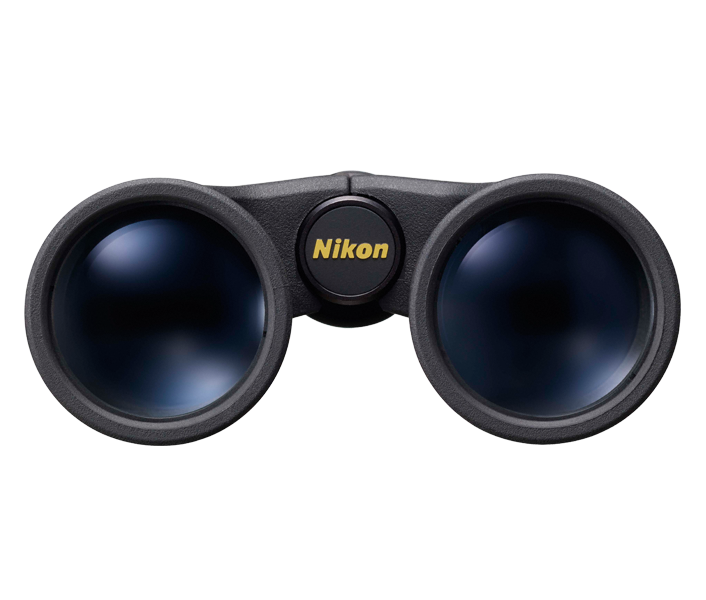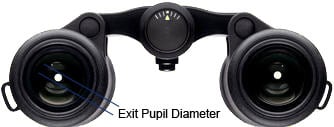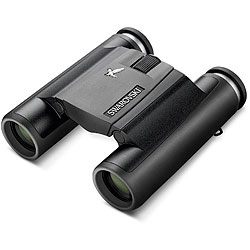Which Compact Binoculars Are Best?
6x21, 8x22, 10x25, 12x25, 10x26, 9x28…
What Size & Magnification Is Best for a Compact & Which Should You Get?

So you have decided that you need a compact binocular, but which configuration (objective lens size and magnification combination) should you get?
Weather you are going on a backpacking travel adventure, a long weekend camping trip, hiking in the mountains or simply want a pair of binoculars to get a better view at a sporting event or a the local gallery or museum, a compact binocular is often the right way to go if need a very small and lightweight instrument.
However
In my article on How Different Configurations Affect a Binocular, I do go through the main points on a wide range of binocular sizes and thus it is well worth reading, especially if you are not entirely sure if a compact binocular is right for your needs.
But in this article, I will assume that you have decided that a compact/pocket binocular is the right size for you and you now need to decide on the best option in terms of the best lens size and magnification for you and your particular needs.
Dimensions & Weight
The whole point of a compact binocular and the reason why you would sacrifice the greater light gathering abilities of larger instruments is to reduce the size and weight so this seems like the logical place to start.
Whilst both the size and weight of most compacts is substantially less than your standard 8x42 or 10x42 binocular, in most cases the difference between a 21mm or 22mm binocular and a 26mm or 28mm one is not huge.
All of these lens sizes produce an instrument that would consider being a compact binocular and for the most part are both easy to carry and fit easily enough into your daysack.
But for some specialist uses, these small differences can make a big difference:
So for example, minimalist backpackers, bikepackers and hikers often require extremely lightweight and compact gear. Then there are also those who want to be 100% sure that the binocular they choose will be able to fit into a jacket or shirt pocket and will thus pay close attention to the exact dimensions and weight of the binocular.
Also note that as well as the lens size, the type of prism used (Porro vs Roof) and the design of chassis (single or double hinge), plays a big part in determining the overall dimensions of a compact binocular. For more on this, take a look at my article on the Best Design for Compact Pocket Binoculars.

Magnification
6x, 7x, 8x, 10x, 12x…
Choosing the right magnification for your desired uses is also extremely important as it affects the way a binocular performs in a whole host of different ways.
So whilst the average person in the street incorrectly assumes that the most powerful binoculars must be the best, this is far from the case and the best magnification almost always depends on your particular requirements:
Viewing Distances & Image Detail
Binoculars with a powerful magnification are in theory able to deliver greater image detail than those with lower powers. Or to put it another way, you are often able to see more at greater distances with more powerful binoculars.
Thus it stands to reason that if you are generally going to be observing objects at longer ranges, a 10x or perhaps even a 12x magnification might be the right option. Although, having said that, there are still many other factors and consequences brought about by the higher power that you still need to take into consideration before making your final choice:
Field of View
As you increase the magnification, the field of view almost always decreases. This makes sense as the higher the power, the more “zoomed in” you are and thus as a consequence, you are able to view less of the bigger picture.
So whilst you do get more image detail with a higher magnification like 10x or 12x, you may have to pan the view about to get a complete view of everything that is going on or indeed miss out on something important altogether.
Not only do you see a “bigger picture”, but the wider views on lower powered binoculars with 8x, 7x or even 6x magnifications make it much easier and thus usually quicker to locate and then follow moving objects. This is especially important at mid to close range and when viewing small, fast-moving objects like birds and is one of the main reasons why most experience birders opt for lower powered 8x or 7x binoculars.
Image Stability
Every tiny movement that comes from your fingers, hands and arms gets amplified by the magnification, thus this means that higher powered binoculars make it harder to maintain a steady, shake-free view.
So even though higher magnifications can, in theory, provide you with more image detail, there can be times when you are not able to take them in because there is too much image shake.
Binoculars with 6x and 7x binoculars make it very easy to keep a steady view and in my experience, the difference between an 8x power and a 10x power is not massive. I can personally maintain an acceptably stable image for most terrestrial uses with a 12x magnification, but any higher and I almost always need to use a tripod.
This experience will change from user to user and is dependent on some specific uses where being able to minimize image shake can be extremely important:
- If you have particularly unstable hands, which is often the case with children or the elderly, it is often wise to keep the power to a maximum of 8x or preferably lower.
- If you will be using your binoculars from an unsteady platform like a vehicle, boat or canoe – this is one of the main reasons why marine binoculars tend to have lower 7x magnifications.
- For Astronomy. Use a tripod with higher magnifications, but for handheld astronomy, if you want a clear view of the stars, keep the power down.
Minimum Focal Distances
Whilst not always the case, the minimum focus distance tends to be closer on binoculars with lower magnifications.
Most people use binoculars to observe distant objects and so this will be of little importance. However there are also some uses where having a very close minimum focus distance is desirable.
- Studying butterflies and other insects at close range
- Take your binoculars to an Art Gallery or Museum

Objective Lens Size
Like the magnification, the objective lens diameter makes a big difference to how a binocular performs and as a result which areas it is most suitable for use.
Their size obviously plays a large part in determining the overall dimensions of the instrument and larger lenses generally weigh and cost more to make. However their size also has a big effect on the image quality, brightness and low light performance of the device.
Image Quality & Brightness
Think of the objective lenses like the windows in a house. Large sliding glass doors on your patio are able to capture and let in much more light than a tiny attic window.
In the same way, big lenses are able to capture and potentially transmit more light into the instrument. This increase in light ‘information’ can improve image brightness and quality.
It is for this reason that astronomy binoculars tend to have very large 50mm, 70mm or even 100mm diameter lenses.
Here on BBR, I consider any binocular with an objective lens of under 28mm to be a compact binocular and whilst you can in theory have any dimension, common sizes include 26mm, 25mm, 22mm, and 21mm. Here the differences are relatively small, but there is still a difference and it is well worth keeping the effects in mind:
Exit Pupil & Low Light Performance

Very closely related to the objective lens sizes is the size of the shaft of light exiting ocular lenses that then passes onto your eyes. Known as the exit pupil, it’s size on a Roof or Porro prism binocular is largely determined by dividing the lens diameter by the magnification.
So a standard 8x42 binocular has a relatively large 5.25mm (42÷8) exit pupil and an 8x21 compact has a much smaller 2.6mm one (21÷8).
This is very important to be aware of because your eyes require enough light for you to be able to perceive a bright, high-quality image.
In normal daylight conditions most people’s pupils tend to measure around 3mm in diameter, so, in these conditions, exit pupils much larger than 3mm are not really necessary as the extra light does not pass into your eyes.
Note: Larger exit pupils also make it easier to line your eyes up with the ocular lenses and achieve an image without black rings on the edges.
However and as you probably know, the pupils in your eyes expand in low light conditions, allowing them to take in more light. Their maximum diameter varies from person to person and with age, but in general, we take 7mm as being a good rule of thumb. Thus if you want a binocular with an excellent low light performance, you need a large exit pupil of around 7mm. To achieve this you either need extremely large lenses or a very low power, or a combination of both. So, for example, a popular low light binocular is a 7x50 and has a 7.1mm exit pupil (50÷7).
Thus even if we take the “largest compact” with 28mm lenses and combine it with a relatively low power, say 8x, you still only achieve an exit pupil of 3.5mm (28÷8).
Exit Pupil Sizes of 8x Compacts
- 8x28 = 3.5mm (28÷8)
- 8x26 = 3.25mm (26÷8)
- 8x25 = 3.15mm
- 8x22 = 2.75mm
- 8x21 = 2.63mm
The higher the magnification, the smaller the exit pupil on the corresponding lens size:
Exit Pupil Sizes of 10x Compacts
- 10 x 28 = 2.8mm
- 10x26 = 2.6mm
- 10x21 = 2.1mm
Other Common Configurations
- 12x25 = 2.1mm
- 9x28 = 3.1mm
- 7x25 = 3.6mm
- 7x28 = 4mm
- 6x25 = 4.1mm
This is one of the weaknesses you have to accept when choosing a compact binocular. In poor light, you will not perceive as bright an image as a larger binocular with the same or similar magnification.
So it is true to say that whilst perfectly fine in normal daylight conditions, no compact is particularly good in very low light. However should you often operate in dim light like you get at twilight or in thick forests, you would be better of choosing a combination that produces an larger exit pupil. Or to put it another way, stay away from high powered compacts if you want a good low light performance.
Conclusions
Hopefully, I have been able to demonstrate that even within the subset of compact binoculars, the combination of the lens size and magnification has a big effect on its performance and making the right choice for your particular needs is important.
Choose a lower magnification (6x, 7x or 8x)
If you are going to be using your binoculars in less than ideal light conditions, at closer or extremely close ranges or need a very steady view.
Common Configurations & Where to Buy:
- 6x21 Binoculars – Often Used for Kids & Children’s Binoculars
- 6x22 Binoculars – Often Used for Kids & Children’s Binoculars
- 7x25 Binoculars
- 7x28 Binoculars – Great for uses like birdwatching at very close range
8x Compacts are very versatile and ideal for general use, nature, sporting events, wildlife observation & birding at close to medium ranges:
Choose a higher power (10x or 12x) – If you are going to be out in the open and observing objects at greater distances. These higher power binoculars are more popular with wildlife observation and
Tiny lenses (21mm / 22mm) are for those requiring the smallest, most lightweight instrument possible, but be aware this comes at the expense of image brightness and potentially image quality as well.

 Article | Posted by Best Binocular Reviews
Article | Posted by Best Binocular Reviews 
 Categories:
Categories:  Tags:
Tags: 

